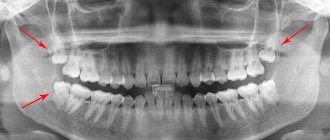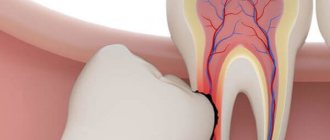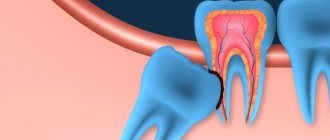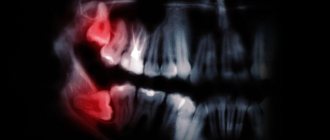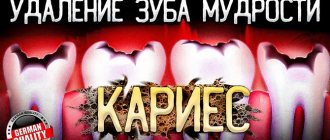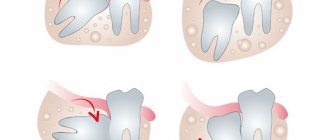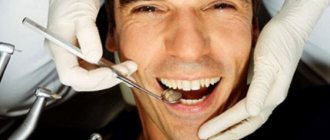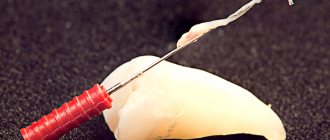Removal of the upper wisdom tooth under the guidance of surgeons with 25 years of experience, in conditions of increased comfort and at competitive prices.
One of the most labor-intensive procedures in dentistry is the removal of the figure eight in the upper jaw. Due to its abnormal location, the presence of roots with tortuous bends, as well as in the case of partial eruption of wisdom teeth and the proximity of the maxillary cavities, extraction becomes the only way out of the situation. In this case, it is better to deal with qualified specialists and contact trusted clinics.
In our dentistry you will be met by professional surgeons who know modern methods of removing problem teeth, use advanced instruments and effective anesthetics in their work. All this guarantees a shortened procedure time and the absence of any discomfort during it.
From this article you will learn in detail about all the nuances associated with the removal of a wisdom tooth in the upper jaw.
Free consultation
Our specialists will conduct a free consultation and select the best treatment option for you.
Sign up now! Online registration
+7 (495) 649-41-19
Content
1 Is it easier to remove a wisdom tooth in the lower or upper jaw?
2 In what situations is it necessary to remove a wisdom tooth in the upper jaw?
3 Anesthesia for removal of the upper wisdom tooth
4 Simple removal of wisdom teeth in the upper jaw
5 Difficult removal of the upper wisdom tooth
6 Removal of a completely destroyed upper wisdom tooth
7 Is it painful to remove a wisdom tooth in the upper jaw?
8 Consequences after removal of the upper wisdom tooth
9 Recommendations for recovery after removal of the upper wisdom tooth
10 Prices for wisdom tooth removal in the upper jaw
Content:
- Peculiarities
- Indications
- Contraindications
- Operation
- Removal methods
- Difficult removal
- Stages
- Diagnostic value
- Does it hurt to remove
- Possible complications
Wisdom teeth or “eight” teeth, located at the edges of the jaw, erupt much later than their counterparts. Moreover, this often happens in adulthood, causing a person many unpleasant moments. The fact is that the structure of the human jaw does not provide enough free space to comfortably accommodate an additional pair of teeth. Therefore, “eights” often put pressure on “sevens”, they grow at an angle, their roots become curved, and it can be difficult to provide them with proper hygienic care, as a result of which caries develops. The peculiarities of the location do not allow for high-quality treatment of the wisdom tooth, and the optimal solution is its removal, since it bears neither a functional nor an aesthetic load.
Is it easier to remove wisdom teeth in the lower or upper jaw?
Wisdom teeth are the last to appear on the jaw and have a complex structure, which greatly complicates treatment procedures. In addition, due to the presence of widely spaced and curved roots, the process of extracting the “eights” is significantly more complicated. However, there are significant differences between the removal of such teeth in the upper and lower jaw.
Molars located in the lower jaw are more difficult to extract because they experience more pressure and have more tortuous and durable roots. As a result, when extracting “eights” in this section, the surgeon applies more force, which can cause injury to adjacent units or gums, as well as a jaw fracture. Moreover, lower eighth teeth have 1-2 more roots than their upper counterparts, which also complicates the extraction process.
As for the removal of the upper wisdom tooth, the situation here is somewhat different. The upper jaw is less dense and has a larger number of vessels and nerve endings. Moreover, when anesthetics are administered before removing a wisdom tooth in the upper jaw, any consequences in the future are excluded. In turn, anesthesia of the mandibular region is accompanied by loss of sensitivity of the tongue, face and throat.
When is surgery necessary?
Wisdom teeth are more likely to develop pathological processes than others. There are several indications for the procedure:
- Dense or crowded teeth. As a result, the eruption of the wisdom tooth is complicated - it grows at an angle and causes pain. Inflammation occurs, and to solve the problem, surgery is performed to remove the wisdom tooth.
- Incorrect bite, requires braces. “Eights” can shift the dentition and cause pain when wearing braces. To avoid such problems, it is necessary to remove unerupted wisdom teeth.
- Lesions - caries, pulpitis, periodontitis become the reason for surgical intervention. Carrying out therapy is problematic, so they resort to removal.
At DENTA dental blades, you can undergo the procedure of wisdom teeth removal inexpensively - at a cost of 6,480 rubles. The price varies depending on the complexity and volume of work and the anesthesia used. To find out how much it costs to remove wisdom teeth, call us at the numbers provided.
In what situations is it necessary to remove a wisdom tooth in the upper jaw?
In some cases, it is possible to save the “eight”. For example, in the presence of carious lesions, inflammatory processes in the pulp area or periodontal tissue disease. If you contact a specialist in a timely manner, the necessary treatment measures are carried out, and the damaged tooth can be restored.
However, in advanced situations, treatment becomes impossible, and removal of the wisdom tooth in the upper jaw is the only solution to the problem. Moreover, such a need may appear already during the period of eruption of the “eight”, which is accompanied by the occurrence of severe pain, an increase in body temperature and the appearance of edema. In this case, the indication for surgical intervention is the atypical shape of the roots, their incorrect location and curvature of the tooth.
Next, we will describe the factors that require immediate removal of a wisdom tooth in the upper jaw. These include:
- If a recently erupted or impacted tooth has an abnormal location, which creates obstacles to the growth of neighboring units and injures the gum tissue;
- In the presence of massive carious lesions and significant damage to the crown;
- Trigeminal neuralgia, accompanied by burning, intense pain;
- Inflammatory process in the area of gingival tissue located in close proximity to the erupting tooth;
- Fixation of bracket systems in situations where the last “eight” in a row prevents changes in the position of neighboring units;
- The presence of cystic formations in the root area.
According to leading experts in the field of dentistry, it is necessary to monitor the condition of wisdom teeth at the initial stage of their development. For preventive purposes, an x-ray is taken. Based on the results of this examination, the doctor identifies existing pathologies and gives appropriate recommendations.
If a specialist diagnoses the fact of an abnormal position of the tooth, then, most likely, he will advise immediate extraction of the root system. Removal of unerupted upper wisdom teeth is performed with less effort. In this case, there is no likelihood of negative consequences, and the recovery period is much easier.
How to prepare for removal
If the process of the emergence of the third molar causes concern or is accompanied by pain, then it is necessary to show the problem unit to the dentist as soon as possible. You should not postpone a visit to the clinic, abuse painkillers or use “miracle” folk remedies - this will not help solve the problem and may worsen it.
After treatment, there are 2 possible scenarios - the wisdom tooth will be treated or removed. To properly prepare for removal, just follow a few simple recommendations.
- 1 - 2 days before the procedure, stop taking alcohol and anticoagulants - drugs that impair blood clotting, for example, Aspirin, Heparin, Ibuprofen.
- On the eve of the operation, it is better not to practice warming procedures - go to the bathhouse, sauna, solarium, or steam your feet.
- Be sure to eat 1 – 2 hours before removal.
- Before visiting a doctor, thoroughly brush your teeth and mouth with a regular toothbrush and toothpaste.
Immediately before removing a wisdom tooth, it is recommended to lubricate your lips with Vaseline or hygienic lipstick - this will protect them from the formation of cracks. As a rule, in good clinics the dentists do this themselves, but just in case, it is better to take the product with you from home.
It is important to know! According to the observations of dentists, seeking help earlier guarantees a less painful procedure.
This is due to the fact that the place where the figure eight appears is not yet “exhausted” by pain, slightly inflamed, without swelling and other unpleasant symptoms. In this case, an injection of anesthesia will be sufficient to completely numb the procedure.
If you endured it for a long time, took pills, and then couldn’t stand the torment and asked for help, then you need to be prepared for the fact that, most likely, the operation will be more painful and the dentist will have to use a larger dose of anesthesia, which is not always possible.
Regardless of the time of treatment, it is necessary to understand that figure eight extraction is a rather complex process from a technical point of view, requiring the efforts of a doctor. Naturally, tooth extraction will be accompanied by unpleasant sensations. The degree of their manifestation depends on the patient’s pain threshold - therefore it is better to warn the specialist in advance about the characteristics of your body.
Anesthesia for removal of the upper wisdom tooth
As a rule, before extracting the “eight”, they resort to local painkillers - injections with articaine, lidocaine and other drugs with a similar spectrum of action. The dentist makes 2 injections - from the side of the palate and on the outside of the upper jaw. This allows you to obtain a powerful anesthetic effect, which manifests itself within 2-5 minutes after administration.
In the case of the eighth tooth, located in the mandibular region, at least 9-10 minutes are required due to the increased bone density in this area.
However, the pain syndrome can make itself felt within 2-3 hours after surgery, which requires additional use of painkillers and anti-inflammatory drugs.
Recovery period
After the procedure, it is not recommended to consume hot food or drinks. Do not rinse your mouth for 24 hours to prevent a blood clot from accidentally falling out. It is not recommended to smoke for at least two days. Nicotine constricts blood vessels, which prevents the wound from healing. Do not overheat or apply a heating pad to your jaw, as this may cause bleeding.
To relieve pain, you can take an analgesic or apply a cold compress to the cheek in the projection of the sore spot. Solid foods should be chewed on the side of the jaw that has not been operated on.
If there are no complications, then after a few days the wound will heal and the restrictions can be lifted.
Simple removal of wisdom teeth in the upper jaw
When performing the above procedure, the need to use a scalpel and dissect the gums is eliminated. Most often in this situation they resort to the help of a special surgical instrument - an elevator, or standard hand forceps.
Such removal of the upper wisdom tooth, as evidenced by reviews, is performed when there are no obstacles to removing the tooth from the socket:
- The root of the tooth is of medium length, without curvature;
- The “eight” protrudes onto the gums, which makes it possible to remove it with forceps;
- The tooth is single-rooted, or it has several roots fused into one.
To facilitate the extraction procedure, the specialist uses forceps with an S-shaped bend. If an upper wisdom tooth, significantly destroyed by caries, is removed, they resort to bayonet instruments, which are considered universal for carrying out this kind of manipulation. The latter have cheeks with a pointed shape, which have the ability to close and firmly hold the tooth roots.
Algorithm of surgical intervention:
- Applying the instrument to a figure eight crown.
- Immersion of the cheeks under the gum tissue covering the neck of the tooth.
- Advance the forceps to the desired depth and fix them on the tooth.
- Loosening of the unit in the buccal direction and its dislocation (luxation).
- Extraction of a wisdom tooth from the alveolar socket (traction).
To stop bleeding, the surgeon quickly applies a gauze pad to the sore area. As a rule, the duration of the procedure does not exceed 10 minutes.
Patient reviews
Review 1
Before describing the procedure, I want to talk about my pain threshold. I can NOT stand pain. At all! I LOVE IT!!! For example, before treating caries, I ask you to give me 2 painkiller injections. And then one day my wisdom tooth began to hurt. I endured it steadfastly! But patience has come to an end! I had to go to the clinic.
Sitting down in a chair, I, as usual, asked for 2 injections and mentally prepared myself for torture :) Instead of somehow supporting and encouraging me, the doctor said: - Nahhh... but the tooth is in an inaccessible place! You can’t even get close to him!!!
Then she asked me to open it wider, then even wider, then again and again... It seemed to me that the corners of my mouth were already torn, and the doctor kept asking me to make my “mouth wider”! At the same time, she said, “What can I do here...” and tried to pick up the tooth with pliers.. These attempts lasted about 5 minutes. There was no particular pain, it was just unpleasant that the doctor could not pick up the tooth and was scared from waiting for the outcome. In the end, I asked: - Maybe I’ll go already?!!! If she can’t pick up a tooth, then WHAT will happen next?! To my deep surprise, the doctor did not even try to persuade me to stay and complete the procedure. She simply said: “Go!”
Well, wow :) This has never happened to me before. Usually doctors persuade: - Well, be patient... If you came, then you need to be patient. And here on you - go... I ask: - And what to do now? The answer was: “Nothing!” Rinse! And don't eat anything for 2 hours. And don't drink anything hot all day. - Why??? - Because the wound should heal. - So you REMOVED my tooth??? - Yes!
Just like that! While I was preparing for “medieval torture” and many hours of torment, the specialist did her job! BRAVO!!! I was delighted! After a couple of hours, the freezing sensation began to subside and the pain returned. She was tolerable, rinsing helped. After a few days the pain went away, but the wound healed for probably a whole month! The pain was weak and dull... The gums ached a little and as if something was pulling. But everything ended well! Everything is overgrown evenly.
Review 2
One of the four teeth had grown into the gum and began to rot there. Therefore, when I came to my favorite dentist, there was only one diagnosis - the wisdom tooth needed to be removed. I honestly couldn’t even get scared when I was already given anesthesia and the fragile dentist started pulling my tooth.
From the sensations, I can’t say that it hurt, no, the anesthesia worked well, but there was a feeling, I felt the tooth being taken with forceps, how it was being pulled, and I was even surprised how my fragile doctor pulled out this chunky tooth. He fought hard to get out, but for professionals there are no problems.
After this, of course, my gums bled a little, I was prescribed mouth rinses so that everything would heal faster. My gums healed within a day. I did not feel any discomfort due to the missing wisdom tooth.
Therefore, I can say for sure that the devil is not as scary as he is painted. Yes, it was unpleasant, but not painful and it could be tolerated. And if I have to remove the rest of my wisdom teeth, I won’t be the least bit upset or scared. Since there is nothing scary in this procedure.
Complex removal of an upper wisdom tooth
As part of this procedure, drills are used, and the gingival tissue is dissected and the dental socket is sutured. Swelling after such removal of the upper wisdom tooth is considered a normal manifestation. The reason for this operation is the eruption of the tooth in a horizontal position, under a layer of bone tissue.
Procedure steps:
- Initially, the site of future intervention is anesthetized.
- The gum is dissected and part of it is peeled off using a scalpel.
- A hole is created in the bone tissue. In this case, special tips and cutters are used to provide a cooling effect.
- Full or partial extraction is performed.
- The dental alveolus is thoroughly washed with an antiseptic solution.
- The bone wound undergoes plastic surgery, and the detached part of the gum is returned to its place.
- Suturing the alveolar cavity and stopping bleeding.
After implementing all the sequential steps and removing the upper wisdom tooth, the specialist makes recommendations regarding further care.
Removal of a completely destroyed upper wisdom tooth
If a patient has a completely destroyed wisdom tooth, removal of the upper molar becomes inevitable, since it becomes painful for the person to chew food. Unfortunately, not every specialist can cope with such a situation. Sometimes the “eight” has to be removed in parts, which requires a significant investment of time and painstaking work of an experienced surgeon.
First of all, this is due to the difficulties that arise when trying to fix a tooth with forceps. In this case, it may be necessary to dissect the gum tissue. In particularly difficult situations, it may be necessary not only to crush hard tissue, but also to saw through the bone in order to free access to the root part of the tooth.
Such surgical intervention is best performed in patients no younger than 40 years of age, since it is during this period that the alveolus undergoes atrophy.
Is it painful to remove a wisdom tooth in the upper jaw?
According to many dental visitors, they are afraid of pain during the extraction procedure of the upper eighth teeth. Fortunately, today powerful anesthetic drugs have been developed that can relieve pain.
As a rule, patients report discomfort after surgery. This is due to the cessation of the action of painkillers. To get rid of unwanted complications after removal of the upper wisdom tooth during the recovery period after surgery, the specialist additionally prescribes anti-inflammatory and anesthetic agents.
At the Elident clinic, experienced surgeons with 25 years of experience will work with you, who use modern instruments in their work, regularly carry out interventions related to the extraction of “eights” and use effective methods of anesthesia. This guarantees increased comfort during the procedure and eliminates complications after it. In addition, we provide important recommendations that must be followed after the removal of the upper wisdom tooth in order to avoid unwanted manifestations in the future.
Our clinics
Clinic "Elident" on Varshavskaya
Varshavskoe highway, 75, bldg. 1, Moscow 117556
- Varshavskaya (500 m, closed until 2021)
- Nakhimovsky Prospekt (1,300 m)
Mon-Sat : 09:00-21:00; Sun : 09:00-19:00.
Online registration
+7 (495) 649-41-19
Elident Clinic in Annino
Varshavskoe highway, 154, building 1, Moscow 117405
- Annino (500 m)
- Academician Yangelya (700 m)
Mon-Sat : 09:00-21:00; Sun : 09:00-19:00.
Online registration
+7 (495) 649-41-19
Consequences after removal of the upper wisdom tooth
Often, after the removal of upper impacted wisdom teeth, serious consequences become apparent, including:
- Injury to the oral cavity or soft tissues, which is caused by improper placement of the “eight”;
- If the damage is severe, a fracture of the root or crown part is possible. This is accompanied by an uncharacteristic crunch;
- Dislocation of an adjacent unit. If excessive force is applied or an inexperienced specialist participates in the procedure, nearby teeth may be damaged;
- Breaking off a piece of a tooth root. This occurs due to the instruments gripping the tooth too deeply;
- Alveolitis. It appears when the necessary rules of care are ignored or in the presence of chronic inflammatory processes, or when parts of the tooth are not fully extracted from the socket;
- Damage to the lower part of the maxillary cavity. One of the most severe complications.
Removal steps:
- Preliminary diagnosis. The doctor examines the oral cavity. Takes x-rays if necessary. Gives recommendations on possible treatment or decides on the need for surgical intervention;
- Removal takes about 45 minutes. At this time, the dentist administers anesthesia, after which he removes the molar from the socket;
- At the patient’s request, a regenerative procedure is performed to quickly restore damaged tissue;
- The doctor gives you recommendations and also prescribes medications.
Recommendations for recovery after removal of the upper wisdom tooth
After extraction of the upper wisdom tooth, at least 1-2 days are required for the patient’s rehabilitation. In some cases, this period may be delayed. To avoid complications, you must adhere to the following recommendations:
- Use antibacterial therapy prescribed by a specialist, as well as drugs that relieve inflammation and pain;
- Refuse to visit the sauna, swimming pool and bathhouse - in order to eliminate the possibility of wound infection;
- In the first days after the intervention, it is recommended to use soft products;
- If possible, stop using tobacco products.
We employ specialists of the highest category, which eliminates the possibility of making any mistakes during the procedure and guarantees a shortened and easy recovery period.
Prices for wisdom tooth removal in the upper jaw
| Service | Price, ₽. |
| Surgeon consultation | for free |
| Carpule anesthesia (Ultracaine, Septanest, Ubistezin, Alfacain, Mepivastezin) | 500 |
| Application anesthesia of the mucous membrane (Lidocaine) | 150 |
| Removal of a tooth of increased complexity (wisdom teeth 1.8 2.8) | 3300 |
| Removal of impacted dystopic wisdom tooth | 5500 |
| Removal of lower wisdom tooth | 3000 |
| Removal of the lower wisdom tooth (advanced) | 4000 |
| Pocket cut | 500 |
The cost of this service may be influenced by: the complexity of the problem and the rating of the chosen dentistry. For example, the cost of an x-ray examination can reach 300-500 rubles. With a simple removal of the upper wisdom tooth, the price can be equal to 3500-7000 rubles. In turn, if a complex procedure is planned, be prepared to pay at least 4,000-9,000 rubles.
The Elident clinic has fixed an acceptable cost for such services - 3300-5500 rubles (depending on the complexity of the case).
Article expert (author):
